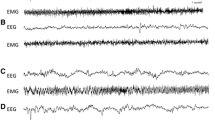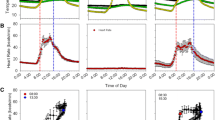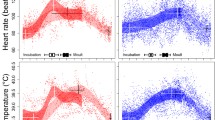Summary
Breathing frequencyF r of resting blue-naped mousebirdsUrocolius macrourus lies between 50–70 per min and correlates directly with ambient temperatureT a and energy metabolismM. The nocturnal mean energy intake per breath varies between 5.6–17.7 mJ/g. At highT a the birds show gular fluttering with a relatively constantF r of about 460 min−1.M shows a constant absolute day-night difference of 25 J/g·h; the relative differences areT a-dependent between 36–168% (lower values at lowerT a). Thermal conductance is 2.10–2.15 J/g·h·°C (predicted 2.67), indicating a good insulation. Basal metabolic rate BMR is reduced by 63% compared to predicted values. At aT a-range of +8–36 °C the birds are normothermic. Below this range nocturnalT b andM decrease slightly with fallingT a. The birds show partial heterothermia (shallow “hypothermia”). Clustering is an effective energy saving strategy which allows loweringM with keeping highT b even at lowT a.
Oxygen-intake is controlled byF r as well as by tidal volumeV t inT a-dependent changing portions.V T can vary between 0.29–0.91 ml (mean value 49.7 ml).
Similar content being viewed by others
Abbreviations
- T a :
-
ambient temperature
- T b :
-
body temperature
- M :
-
energy metabolism
- F r :
-
breathing frequency
- V T :
-
tidal volume
- BMR:
-
basal metabolic rate
- TNP:
-
thermoneutral point
References
Aschoff J (1981) Thermal conductance in mammals and birds: its dependence on body size and circadian phase. Comp Biochem Physiol 69 A:611–619
Bartholomew GA, Trost ChH (1970) Temperature regulation in the Speckled Mousebird,Colius striatus. Condor 72:141–146
Bernstein MH, Schmidt-Nielsen K (1974) Ventilation and oxygen extraction in the crow. Respir Physiol 21:393–401
Brehm A (1911) Brehms Tierleben, vol 8, 4th edn. Bibliographisches Institut, Leipzig
Brent R, Pedersen PF, Bech C, Johansen K (1984) Lung ventilation and temperature regulation in the European CootFulica atra. Physiol Zool 57:19–25
Bucher TL (1981) Oxygen consumption, ventilation and respiratory heat loss in a parrot,Bolborhynchus lineola, in relation to ambient temperature. J Comp Physiol 142:479–488
Bucher TL (1985) Ventilation and oxygen comsumption inAmazina viridigenalis. J Comp Physiol 155:269–276
Bucher TL, Bartholomew GA (1986) The early ontogeny of ventilation and homeothermy in altricial bird,Agapornis roseicollis (Psittaciformes). Respir Physiol 65:197–212
Calder WR (1968) Respiratory and heart rates of birds at rest. Condor 70:358–365
Chappel MA, Bucher TL (1987) Effects of temperature and altitude on ventilation and gas exchange in chukars (Alectoris chukar). J Comp Physiol 157:129–136
Cowles RB (1959) Zulu Journal. University of California Press, Berkeley
Herreid CF, Kessel B (1967) Thermal conductance in birds and mammals. Comp Biochem Physiol 21:405–414
Hoffmann R, Prinzinger R (1984) Torpor and Nahrungsausnutzung bei 4 Mausvogelarten (Coliiformes). J Ornithol 125:225–237
Lasiewski RC (1972) Respiratory function in birds. In: Farner DS, King JR (eds) Avian Biology, vol II. Academic Press, New York, pp 287–342
Lasiewski RC, Bartholomew GA (1966) Evaporative cooling in the Poor-will and the Tawny Frogmouth. Condor 68:253–262
Lasiewski RC, Dawson WR (1967) A re-examination of the relation between standard metabolic rate and body weight in birds. Condor 69:13–23
McAtee WL (1947) Torpidity in birds. Am Midl Nat 30: 191–206
Prinzinger R, Göppel R, Lorenz A (1981a) Der Torpor beim RotrückenmausvogelColius castanotus. J Ornithol 122:379–392
Prinzinger R, Göppel R, Lorenz A, Kulzer E (1981b) Body temperature and metabolism in the Red-backed Mousebird (Colius castanotus) during fasting and torpor. Comp Biochem Physiol 69 A:689–692
Prinzinger R, Jackel S (1986) Energy metabolism, respiration frequency and O2-consumption per breathing act in 11 different sunbird species during day and night. Experientia 42:1002–1003
Reinertsen RE (1985) Energy strategies in the cold. Doctoral thesis, University Trondheim
Author information
Authors and Affiliations
Rights and permissions
About this article
Cite this article
Prinzinger, R. Energy metabolism, body-temperature and breathing parameters in nontorpid blue-naped mousebirdsUrocolius macrourus . J Comp Physiol B 157, 801–806 (1988). https://doi.org/10.1007/BF00691011
Accepted:
Issue Date:
DOI: https://doi.org/10.1007/BF00691011




